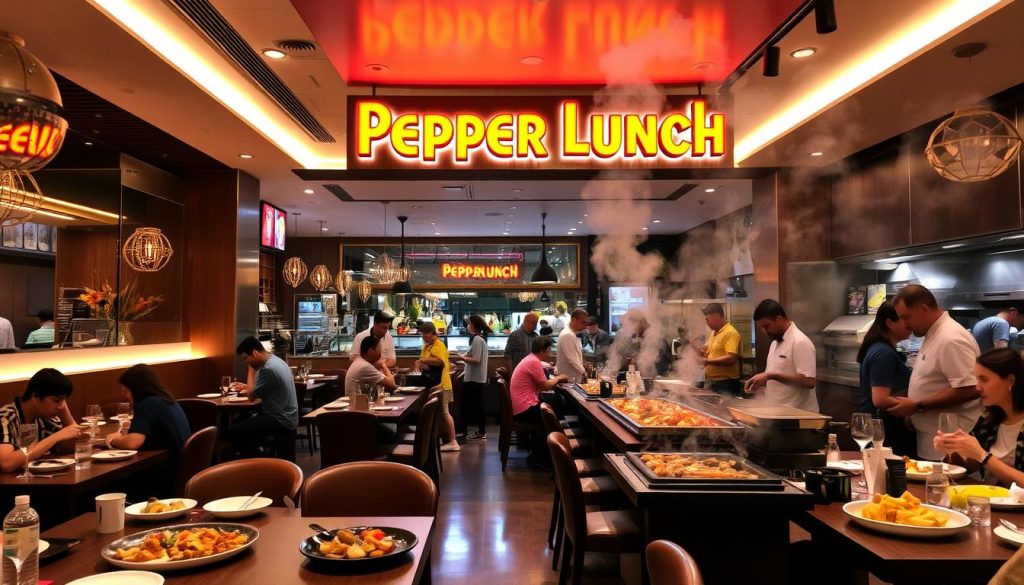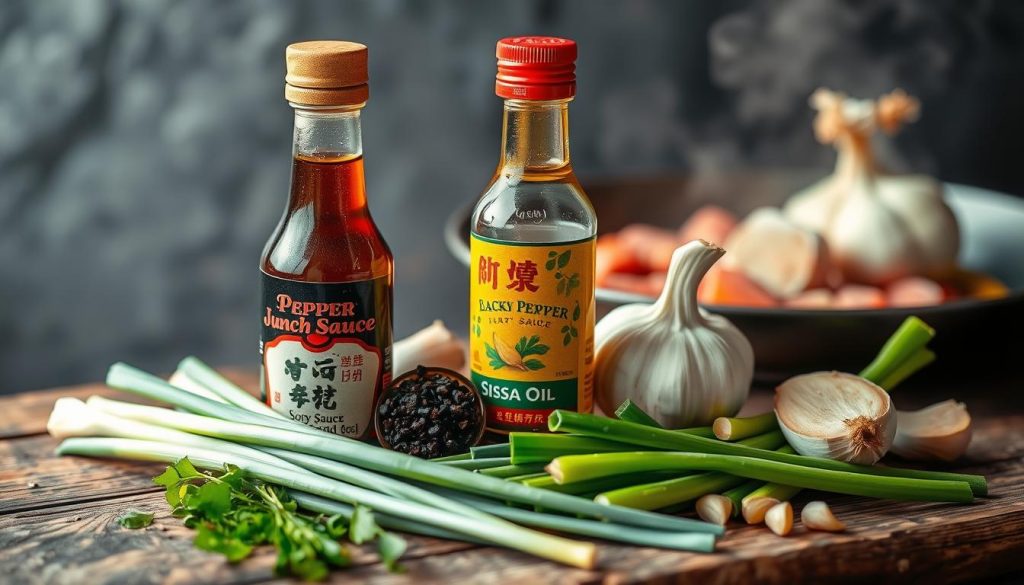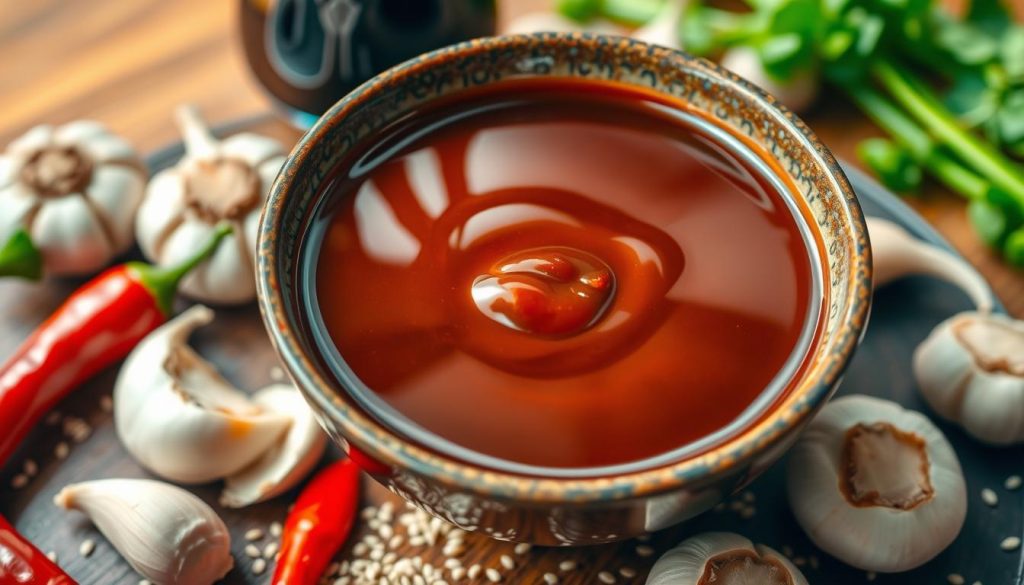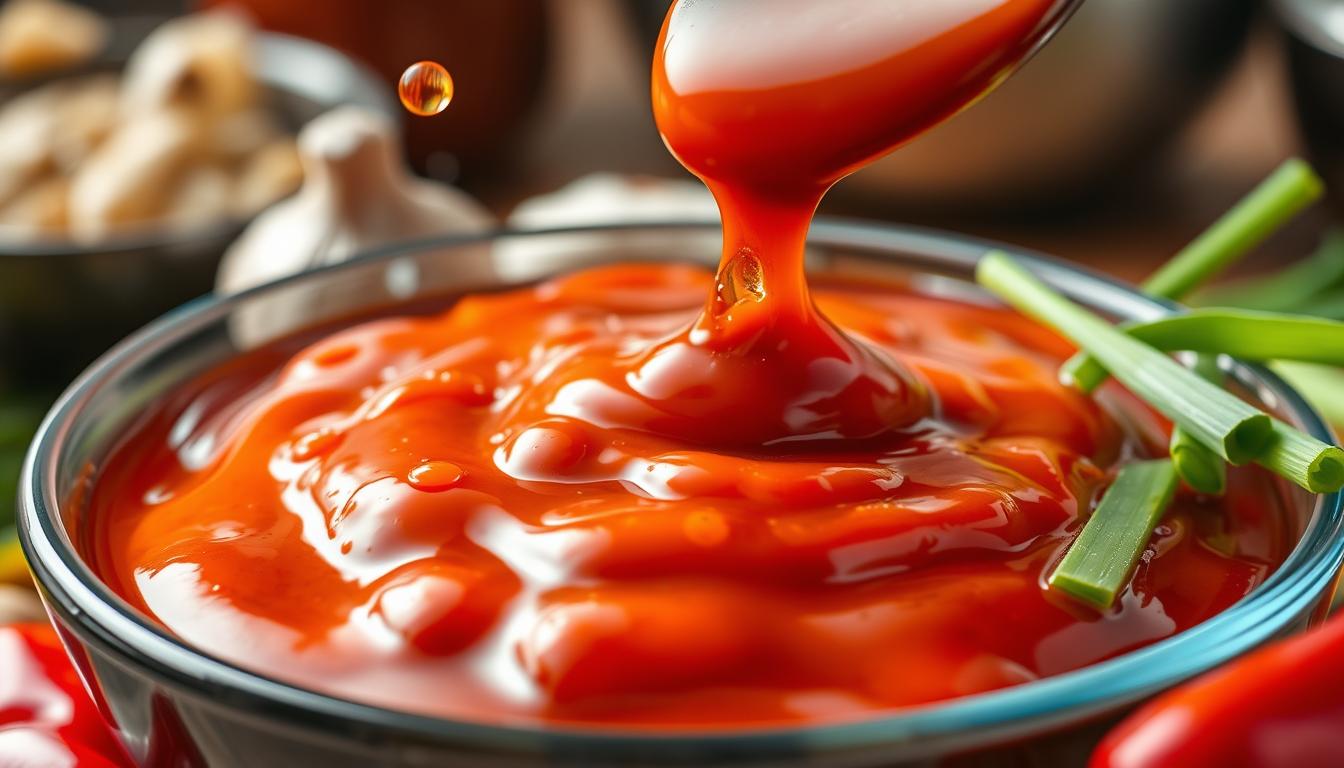I love Japanese food, especially the bold flavors of Pepper Lunch sauces. These sauces, from the famous Pepper Lunch restaurant chain, make simple dishes taste amazing. I’ll show you how to make the authentic Pepper Lunch sauce at home, including Amakuchi (honey brown) and Karakuchi (garlic soy).
Pepper Lunch sauce is special because it’s sweet, savory, and peppery all at once. It’s perfect for quick Japanese meals or to make your dishes taste like Japan. You’ll need just a few ingredients and simple steps to enjoy Pepper Lunch flavors at home.
Next, we’ll look at where Pepper Lunch came from, the key ingredients for the sauce, and how to make different versions. By the end, you’ll know how to make the famous Pepper Lunch sauce at home. Your meals will get a boost of Japanese steak sauce flavors.
Understanding the Origins of Pepper Lunch Restaurant

Pepper Lunch, a famous Japanese fast-food chain, has won hearts with its unique sizzling meals. It started in 1994 by Kushio Ichinose, a creative cook and inventor. Ichinose wanted to change fast food by letting customers make their own meals.
The Story Behind Kushio Ichinose’s Innovation
Kushio Ichinose, Pepper Lunch’s founder, aimed to give customers control over their meals. He created a system where raw ingredients are cooked on hot metal plates. These plates are heated to 500°F (260°C) using special cookers.
Evolution of the Signature Sizzling Plates
The sizzling plates at Pepper Lunch have become a key part of the dining experience. These iron plates are heated to high temperatures, making food taste better. The special sauces, Amakuchi and Karakuchi, add flavor to the dishes.
Global Impact on Fast-Food Culture
Pepper Lunch has changed fast food worldwide. It lets customers cook their meals, breaking the old fast-food mold. This mix of Japanese cooking and modern convenience has made it popular globally, leading to its growth in many countries.
Essential Ingredients for Perfect Pepper Lunch Sauce

To make the perfect Pepper Lunch sauce, a few key ingredients are needed. These ingredients give the sauce its unique umami flavor. Japanese condiments are at the heart of the sauce.
The sauce starts with soy sauce, preferably low-sodium. This lets other flavors stand out. We also add Japanese sake or dry sherry wine for a touch of sweetness. A bit of honey or brown sugar rounds out the flavor.
Black pepper is a must for the sauce’s signature kick. Use freshly cracked or ground black pepper. It adds a peppery heat. Grated garlic is also essential, adding a pungent aroma and flavor.
Some recipes include grated ginger for extra flavor. It adds a subtle warmth and spiciness. Together, soy sauce, sake, sweetener, black pepper, and garlic create the perfect balance. This balance is what makes the Pepper Lunch sauce so iconic.
| Ingredient | Quantity |
|---|---|
| Soy Sauce (low-sodium) | 1/2 cup |
| Japanese Sake (or dry sherry wine) | 2 tablespoons |
| Honey (or brown sugar) | 2 tablespoons |
| Black Pepper (freshly cracked) | 1 teaspoon |
| Garlic (grated) | 3 cloves |
| Ginger (grated, optional) | 1 tablespoon |
The Classic Honey Brown Sauce (Amakuchi) Recipe

The Amakuchi sauce, also known as the honey brown sauce, is a key part of Pepper Lunch’s signature dish. It’s a sweet and savory blend that pairs well with the restaurant’s sizzling plates. Here’s how to make this beloved sauce at home.
Base Ingredients and Proportions
To make the classic Amakuchi sauce, you’ll need the following ingredients:
- Light soy sauce – 1/2 cup
- Honey – 1/2 cup
- Garlic – 4 large cloves, minced
- Cornstarch – 2 tablespoons, mixed with 2 tablespoons of water to create a slurry
Step-by-Step Preparation Guide
Follow these simple steps to create the perfect Amakuchi sauce:
- In a medium saucepan, heat 2 tablespoons of cooking oil over medium heat.
- Add the minced garlic and sauté until fragrant, about 1-2 minutes.
- Pour in the light soy sauce and honey, then whisk in the cornstarch slurry.
- Bring the mixture to a simmer, stirring occasionally, until the sauce thickens and becomes glossy, about 3-5 minutes.
- For a smoother consistency, carefully transfer the sauce to a blender and blend until smooth.
Flavor Enhancement Tips
To customize the Amakuchi sauce to your taste, consider the following:
- Adjust the sweetness level by adding more or less honey to suit your preferences.
- Experiment with the addition of spices, such as ginger, black pepper, or chili flakes, to create a unique flavor profile.
- For a thinner consistency, add a bit more water to the sauce during the simmering process.
With these tips, you can recreate the classic Pepper Lunch Amakuchi sauce at home. Enjoy the perfect balance of sweet and savory flavors.
Mastering the Garlic Soy Sauce (Karakuchi)
If you like a strong, savory taste, try the Karakuchi sauce with your Pepper Lunch. It’s a great choice for those who prefer a deeper flavor than the Amakuchi. This sauce is rich in umami and pairs well with the meats and rice.
The Karakuchi sauce is made with light soy sauce, garlic, black pepper, and cornstarch. By simmering the soy sauce and garlic for 5 minutes, you get a deep, savory flavor. The cornstarch thickens the sauce, and the black pepper adds a nice kick.
To make the Karakuchi sauce, mix soy sauce and minced garlic in a saucepan. Simmer until the garlic is fragrant. Then, add a cornstarch mixture to thicken it. You can also blend it for a smoother texture.
The Karakuchi sauce is not just for Pepper Lunch. It’s great in stir-fries, marinades, or as a salad dressing. Its bold flavor makes it a favorite for those who want something savory.
Whether you’re a Pepper Lunch fan or new to it, learning to make Karakuchi sauce will enhance your meals. Next time you’re at Pepper Lunch, try this garlic soy sauce for a richer taste.
Pepper Lunch Sauce Variations and Combinations
Pepper Lunch sauce is famous for its unique taste. But did you know you can mix it up with different ingredients? You can make it sweet and savory, spicy, or even healthier. Pepper Lunch sauce is super versatile, so you can make it just how you like it.
Sweet and Savory Blends
To make your Pepper Lunch sauce sweeter, try adding mirin or honey. These sweeteners balance out the savory flavors. This creates a delicious mix that makes your steak or chicken taste amazing.
Spicy Alternatives
Want some heat? Add chili oil or sriracha to your Pepper Lunch sauce. This spicy twist adds excitement to the dish. You can adjust the heat to your liking.
Dietary Modifications
Pepper Lunch sauce can be made for different diets. For a gluten-free version, use tamari instead of soy sauce. Vegetarians and vegans can swap oyster sauce for mushroom-based alternatives. This way, you can enjoy Pepper Lunch while meeting your dietary needs.
Trying out different Pepper Lunch sauce variations is a fun journey. Whether you prefer sweet, spicy, or something in between, you can make it your own. This iconic sauce lets you create your perfect steak or Asian sauce blend.
Perfect Pairing: Meats and Rice Plates
The Pepper Lunch sauce is great with many meat and rice dishes. It’s best with thinly sliced ribeye beef, but also works with chicken, pork, and seafood. This creates a mix of flavors that tastes amazing.
One favorite dish is Japanese Beef Pepper Rice. It combines the sauce with rice and beef. You can also try Chicken Pepper Rice or Shrimp Pepper Rice. Each dish shows how the sauce brings out the best in the ingredients.
These dishes often have butter, corn, spring onions, and cheese. These ingredients help make a meal that’s both balanced and tasty. You can put the sauce on the rice and meat or serve it on the side. This lets you adjust the flavor to your liking.
| Dish | Main Protein | Additional Ingredients | Pepper Lunch Sauce Pairing |
|---|---|---|---|
| Japanese Beef Pepper Rice | Thinly Sliced Ribeye Beef | Butter, Corn, Spring Onions | Mixed directly with rice and meat |
| Chicken Pepper Rice | Chicken | Butter, Corn, Spring Onions, Cheese (optional) | Drizzled over rice and chicken or served on the side |
| Shrimp Pepper Rice | Shrimp | Butter, Corn, Spring Onions, Cheese (optional) | Incorporated into the rice and shrimp mixture |
The Pepper Lunch sauce is very versatile. It’s perfect for making tasty Pepper Lunch beef rice, Japanese steak rice, and other Asian meat dishes. Whether you like beef or want to try something different, the sauce makes your meal better.
Storage and Preservation Techniques
Keeping your homemade Pepper Lunch sauce fresh is key. It helps keep the flavors alive and extends its shelf life. Here are some tips to keep your sauces fresh and tasty.
Proper Container Selection
Choose airtight containers for your sauce. Glass or BPA-free plastic works best. Stay away from regular plastic to avoid air and contamination. Freezing in zip-lock bags is great for longer storage, keeping flavors locked in.
Shelf Life Guidelines
Your sauce can last 14 to 21 days in the fridge. Ingredients and how you make it can change this. Freezing it is best for longer storage, keeping it good for months.
Reheating Methods
When reheating, thaw the sauce in the fridge first. Stovetop reheating is best to keep the sauce’s texture and taste. If you’re in a hurry, the microwave works too. Just stir it often to heat evenly.
By following these tips, you can enjoy your homemade Pepper Lunch sauce for a long time. Proper storage and reheating ensure you get the most out of your cooking.
Common Mistakes to Avoid When Making Pepper Lunch Sauce
Making the perfect Pepper Lunch sauce at home is a fun challenge. But, it’s key to avoid common mistakes to get that special flavor. Mistakes like over-boiling the sake and not letting the sauce rest before serving are common. These are a few things to watch out for when making your homemade Asian sauce.
One big mistake is over-boiling the sake. This can change the sauce’s flavor too much. It’s important to find the right balance and watch the cooking closely. Also, not letting the sauce rest before serving can mess up the flavors.
It’s also crucial to balance the ingredients just right. Too much soy sauce, sugar, or black pepper can ruin the taste. Make sure the pan or plate is hot enough to get that Pepper Lunch sizzle effect.
Lastly, don’t use low-quality soy sauce or substitutes. They can ruin the real taste of your Pepper Lunch. Using a good brand makes a big difference in getting the dish’s true flavor.
By avoiding these common Pepper Lunch recipe mistakes, you can make restaurant-quality sauces. With a bit of practice and care, you’ll soon be making homemade Asian sauce like a pro.
Healthier Alternatives and Dietary Modifications
Looking for a healthier take on Pepper Lunch? There are many ways to make tasty, nutritious versions of the signature sauces. By making a few simple changes, you can enjoy the bold flavors of Pepper Lunch while meeting your dietary needs.
Want to cut down on sodium? Try using low-sodium soy sauce or coconut aminos instead of regular soy sauce. These options give a similar savory taste without too much salt. To cut calories, use less honey or brown sugar in the sauce.
Got gluten allergies? Use tamari, a gluten-free soy sauce alternative, for the umami taste. Skip the oyster sauce, which has gluten, and look for gluten-free steak sauce for the flavor you want.
Vegans and vegetarians can make tasty vegan Asian sauce by using mushroom-based sauces instead of oyster sauce. This gives a rich, savory taste without animal products.
Choose leaner meats or plant-based proteins like tofu or tempeh for a low-sodium Pepper Lunch sauce. Serve with nutrient-rich veggies and whole grains like farro or brown rice for a full meal.
With these healthy changes, you can enjoy the great taste of Pepper Lunch while focusing on your health.
Expert Tips for Restaurant-Quality Results
Making authentic Pepper Lunch at home is simpler than you think. As a home chef, I’ve found some key sauce techniques. These tips will help you make your Pepper Lunch taste like it’s from a restaurant.
Start with the best ingredients. The professional sauce techniques I’ve learned stress the importance of quality. This ensures your sauce has the bold, Japanese cooking tips that make Pepper Lunch special.
Let the sauce rest for 10-15 minutes before serving. This step lets the flavors mix and authentic Pepper Lunch flavor develop. Believe me, this small step makes a big difference.
To get the real Pepper Lunch feel, use a hot plate or cast-iron skillet. The sizzle from these surfaces is crucial for the dish’s look. Try different meats and cooking times to find your favorite.
Also, focus on the sauce’s sweet, savory, and peppery balance. Adjust the ingredients to taste, aiming for the perfect mix. You can also blend the sauce for a smoother texture, like the restaurant version.
By using these professional sauce techniques, Japanese cooking tips, and paying attention to detail, you’ll make amazing Pepper Lunch at home. Impress your loved ones with your authentic Pepper Lunch flavor skills!
Conclusion
Learning to make homemade Pepper Lunch sauce lets you bring Japanese flavors into your kitchen. You can make the sweet Amakuchi or savory Karakuchi sauces just how you like them. This journey not only feeds your love for Asian tastes but also lets you make simple dishes taste like restaurant food.
Choose from beef, chicken, pork, or seafood for your Pepper Lunch. The key is Japanese short-grain rice and the special sauce. Mixing soy sauce, garlic, butter, and peppers gives it that tangy, spicy taste. You can enjoy these sauces for days, bringing Pepper Lunch to your table whenever you want.
Discovering how to make Pepper Lunch sauce opens up new cooking adventures. It lets you dive deep into Japanese cuisine from home. With the right ingredients and techniques, you can improve your cooking and enjoy Asian flavors right in your kitchen.

